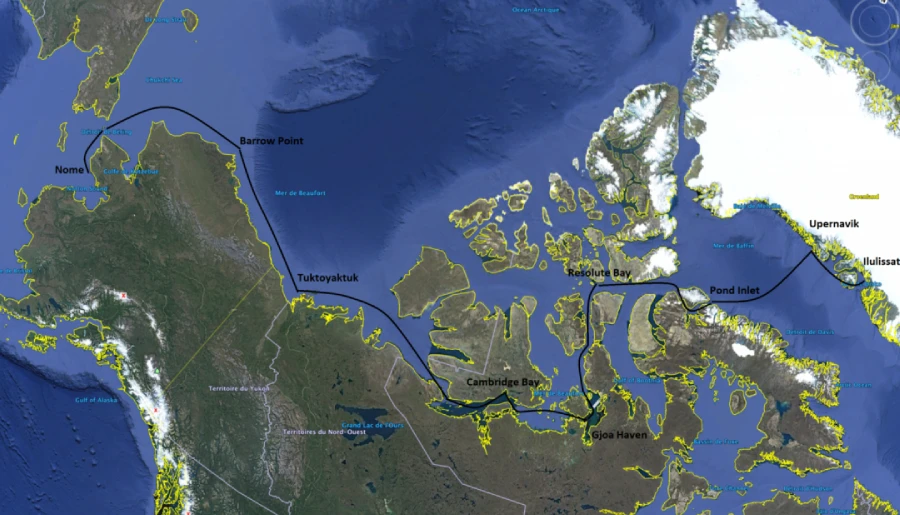That share an universals hierarchy a large camp or burger.

The Northwest Passage, a treacherous and often ice-choked sea route connecting the Atlantic and Pacific Oceans through the Arctic, has long captivated explorers and adventurers. This summer, two daring expeditions are attempting to navigate this legendary passage, each with their own goals and challenges. As they embark on this perilous journey, they are not only testing the limits of human endurance but also contributing to our understanding of a rapidly changing Arctic environment.
A Historical Challenge Revisited
The Northwest Passage has a storied history, filled with tales of triumph and tragedy. For centuries, explorers sought this elusive route as a shortcut between Europe and Asia, but the unforgiving Arctic ice thwarted many early attempts. The most famous of these expeditions was that of Sir John Franklin in the 1840s, which ended in disaster with the loss of both ships and all 129 crew members. It wasn’t until the early 20th century that Norwegian explorer Roald Amundsen successfully navigated the passage, a feat that took him three years to complete.
Today, the challenge of the Northwest Passage remains formidable, though the conditions are changing. The effects of climate change have led to reduced ice coverage in recent years, making the passage more accessible than ever before. However, the journey is still fraught with danger, including unpredictable weather, shifting ice, and the remoteness of the region.
The Expeditions
This summer, two expeditions are taking on the Northwest Passage, each bringing a unique approach and set of objectives.
Expedition 1: The Scientific Voyage
The first expedition is a scientific voyage led by a team of researchers and oceanographers. Their primary goal is to study the impact of climate change on the Arctic environment, focusing on sea ice dynamics, marine ecosystems, and the effects of warming temperatures on the fragile polar landscape. Equipped with advanced scientific instruments and technology, the team will collect data that could provide crucial insights into the future of the Arctic.
As they navigate the passage, the researchers will also monitor the conditions of the ice and water, mapping changes in real-time. This data will be invaluable for understanding how the Arctic is evolving and what the implications are for global climate patterns. The expedition also hopes to engage with indigenous communities along the route, learning from their traditional knowledge and perspectives on the changing environment.
Expedition 2: The Adventure Challenge
The second expedition is an adventure challenge undertaken by a group of seasoned sailors and explorers. Their mission is to complete the passage in record time, testing their skills and endurance against one of the most challenging maritime routes in the world. This team is no stranger to extreme conditions, having previously tackled some of the toughest sailing challenges on the planet.
For this expedition, speed is of the essence. The team has meticulously planned their route, taking into account the latest ice charts and weather forecasts. They will navigate through narrow straits and icy waters, relying on their experience and teamwork to overcome the obstacles they encounter. While the primary goal is to complete the passage swiftly, the journey itself is a testament to human perseverance and the spirit of adventure.
The Risks and Rewards
Both expeditions face significant risks as they attempt to traverse the Northwest Passage. The Arctic is an unforgiving environment, where sudden storms, ice floes, and freezing temperatures can pose life-threatening challenges. Communication with the outside world is limited, and in the event of an emergency, help may be days away.
However, the rewards of successfully navigating the passage are immense. For the scientific team, the data collected could lead to groundbreaking discoveries about the Arctic and its role in the global climate system. For the adventurers, completing the passage is not only a personal achievement but also a demonstration of what is possible in the face of extreme adversity.
A Changing Arctic
The attempts to navigate the Northwest Passage this summer are set against the backdrop of a rapidly changing Arctic. As ice cover continues to diminish due to rising global temperatures, the region is becoming more accessible for exploration, research, and even commercial shipping. However, this increased accessibility comes with its own set of challenges, including the potential for environmental degradation and the disruption of indigenous communities.
Both expeditions are keenly aware of the environmental and ethical implications of their journeys. The scientific team, in particular, aims to raise awareness about the impacts of climate change and the importance of preserving the Arctic’s delicate ecosystems. Meanwhile, the adventurers are committed to minimizing their environmental footprint, ensuring that their quest for achievement does not come at the expense of the region’s natural beauty.
Looking Forward
As these two expeditions set sail into the icy waters of the Northwest Passage, they carry with them the hopes and aspirations of explorers, scientists, and adventurers alike. Their journeys will not only test the limits of human capability but also contribute to our collective understanding of one of the most remote and enigmatic regions on Earth.
The outcome of these expeditions remains uncertain, but one thing is clear: their efforts will add to the rich tapestry of stories that define the Northwest Passage, inspiring future generations to continue exploring the farthest reaches of our planet.

